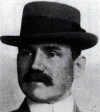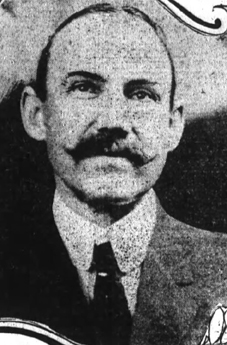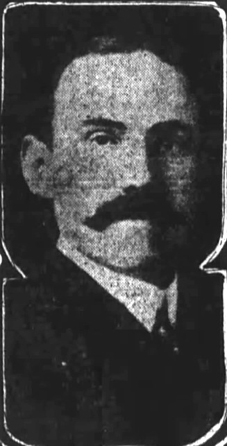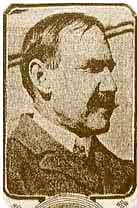Dr. Washington Dodge
First class passenger

“Two men who attempted to rush beyond the restraint line were shot down by an officer who then turned the revolver on himself. ”
Triumph and Tragedy lists him as “Dodge, Dr Washington” (p.340 (7.) ). Various other sources also refer to him as “Dr.” The Bulletin (San Francisco) newspaper of April 19, 1912, who ran an article on Dodge, states his occupation as a ‘San Francisco assessor’ (Philip Hind, Encyclopedia Titanica (8.))
According to the above source, his residence was San Francisco, California. Having embarked at Southampton, the 53 year-old traveled in First Class with his wife, “Mrs. Washington Dodge” (Ruth Vidaver) and their four-year old son “Master Washington Dodge”. Mr. Dodge was reportedly a millionaire. Sinking of the Titanic, Eyewitness Accounts mentions that they “were among the first to land on the dock from the Cunarder. Mr. Dodge carried a life preserver of the Titanic as a memento.” (p.106, 107) According to Encyclopedia Titanica Mr. Dodge “later suffered a breakdown and shot himself, dying on 30th June, 1919.” (Philip Hind, Encyclopedia Titanica (8.))

Dr. Washington Dodge, a millionaire.
(Click image to enlarge)
Having seen off his wife and son in either lifeboat No.7 or No.5 (Triumph and Tragedy lists both), Mr. Dodge himself escaped aboard No.13. It seems apparent from this that he spent most of his time on the starboard side and may have been able to identify Murdoch. Having waited long enough after seeing his wife and son off, he was ‘rewarded’ by being one of the men Murdoch allowed aboard the boats being lowered from his side.
No.13 was launched at 1:35am, possibly by Murdoch, and would have been an unknown distance from the liner by the time of the alleged suicide. It does, however, generally fit into the location and time-frame. In a newspaper article, Dodge explains that he saw these events from a distance: “We could see from the distance that two boats were being made ready to be lowered. The panic was in the steerage, and it was that portion of the ship that the shooting was made necessary.” (The Bulletin, San Francisco, April 19, 1912, Philip Hind, Encyclopedia Titanica (8.))
“Nearly all the passengers had retired when the crash came, about twenty-minutes passed 10 o’clock. The liner was struck on the starboard side, near the bow. The bow, it seemed, withstood the crash, but water rushed into several compartments at the same time...Then the sinking of the Titanic by the head began and the crew was ordered to man the boats. There was no panic. The officers told the men to stand back and they obeyed. A few men were ordered into the boats. Two men who attempted to rush beyond the restraint line were shot down by an officer who then turned the revolver on himself. I could see Mrs. Isador Straus. She clung to her husband and refused to leave him. We floated for four hours until we were picked up. Mr. Ismay left the Titanic on a small boat. I did not see the iceberg. When we got into the boat she was gone. As the Titanic went down, Major Archibald Butt was standing on the deck. I saw him. (Sinking of the Titanic: Eyewitness Accounts, 1912, p.107 (33.))
Although a little disjointed and he incorrectly states the time of collision as 10:20pm (maybe his watch was not adjusted to ship’s time) the rest of his account contains enough to at least show a certain degree of reliability. In another account he also says that as he watched lifeboat No.5 (or 7), containing his wife and child, as it was lowered into the sea he felt “overwhelmed with doubts” as to whether or not he was “exposing them to greater danger than if they had remained on board the ship” (The Titanic, Wade, p.186, 187 (18.)). By this he displayed a degree of honesty as many men were unwilling to admit that they were oblivious to Titanic’s true condition until it was unmistakably apparent.

Dr. Washington Dodge
In the Chicago Tribune, April 19, 1912, Dodge also mentions shots and a suicide:
Among the first of the passengers to leave the pier were Washington Dodge, his wife, and his 7 year old son, whose large eyes shone with excitement from beneath the rolls of white mufflers that bound him from head to foot.
A camera man set off a flashlight directly in front of the party, but it only seemed to please the little boy. He shouted with joy. Mr. Dodge said he estimated that the time the ship sank was 12:15 a.m.
He said the last man he saw was Archibald Butt, who was standing stiff and erect on the deck.
Mr. Dodge was asked if he heard any shots. He replied, “Yes.”
“Suicide?” asked a reporter.
“I am afraid so,” said Mr. Dodge.
The Encyclopedia Titanica website by Philip Hind includes in his biography a series of newspaper articles about Mr. Dodge and his family, notably two San Francisco Bulletin articles of the 19th and 20th of April, 1912. Contained in these are a detailed recounting of his experiences, which show a similar degree of accuracy plus an addition of rumour gained from other sources (please refer to Dodge’s biography, Encyclopedia Titanica (8.)).
In the The Bulletin, San Francisco, April 19, 1912, Dr. Dodge mentions shootings three times in his account:
“Some of the passengers fought with such desperation to get into the lifeboats that the officers shot them, and their bodies fell into the ocean....As the excitement began I saw an officer of the Titanic shoot down two steerage passengers who were endeavoring to rush the lifeboats. I have learned since that twelve of the steerage passengers were shot altogether, one officer shooting down six..." Dodge said that when the boats were drawing away from the ship they could hear the orchestra playing “Lead, Kindly Light,” and rockets were going up from the Titanic in the wonderfully clear night. “We could see from the distance that two boats were being made ready to be lowered. The panic was in the steerage, and it was that portion of the ship that the shooting was made necessary.” (The Bulletin, San Francisco, April 19, 1912 ) (42.)
His description of the staboard evacuation includes his interesting interpretation as to why there were fewer numbers than the port side:
"I watched all boats on the starboard side, comprising the odd numbers from 1 to 13 as they were launched. Not a boat was launched which could not have held from ten to twenty five more persons. At no time were there many people on the starboard side that night. Why was that? The most plausible reason I can give is that the captain was in charge of the launching of the boats on the port side. Now in times of danger the captain always draws a crowd. ...Again, the orders for the women and children to go to the port side greatly increased the number there...It may explain why the boats were launched from the starboard side so much more quickly and successfully, and why, when the last boats on this side reached, Nos. 13 and 15, there were practically no women around, and not many men. When the order to launch the boats was given, Captain Smith took command of the port side and never left there. Chief Officer Murdock took command on the starboard side. (San Francisco Chronicle May 12, 1912, courtesy of The Virtual Museum of the City of San Francisco (42.)
And finally in one of the bulletins he also mentions the use of revolvers and a shooting:

Dr. Washington Dodge.(42.)
“While order prevailed until the last lifeboat had been lowered, hell prevailed when the officers, who had kept the steerage passengers below, with their revolvers pointed at them to prevent them from making their way to the upper deck. When the steerage passengers came up many of them had knives, revolvers and clubs and sought to fight their way to the two unlaunched, collapsible boats. Many of these were shot by the officers. (The Bulletin
San Francisco, April 20, 1912, courtesy of The Virtual Museum of the City of San Francisco (42.)
In summary Murdoch biographer Elizabeth Gibbons describes Dodge in the following passage:
"Dr. Washington Dodge, Sr., saved by being allowed into No. 13 by Murdoch, would be quoted in the San Francisco Chronicle on April 19, 1912, as an eyewitness to the incident; he would identify the officer involved as Murdoch. However, in his speech of May 11, 1912, before the San Francisco Commonwealth Club, Dr. Dodge commented disfavorably upon newspapers printing statements attributed to either himself or Mrs. Dodge which they had never made. Only one thing he was reported to have said was accurate, Dr. Dodge said; unfortunately, he did not identify which one. Witnessing the suicide can be ruled out, however, as No. 13 was launched at approximately 1:25 am and was too far away by the time of the shooting for anyone to have seen the decks clearly." (55.)
It could be assumed by some that he was merely retelling stories he had heard regarding Ismay, Butt, the Strauses and the shootings, and not necessarily an eyewitness to each event. This is probably correct, as the inaccuracies of his statements generally seem to be regarding events that occurred after the launch of his lifeboat, No.13. But alternatively, there is no reason why his lifeboat, no.13, was not close enough for him to see what he said he did. Remembering his status, a millionaire, it can be asked if he would take the risk of perpetrating mere speculation –bordering on defamation if it was false- about Murdoch.
Verdict: